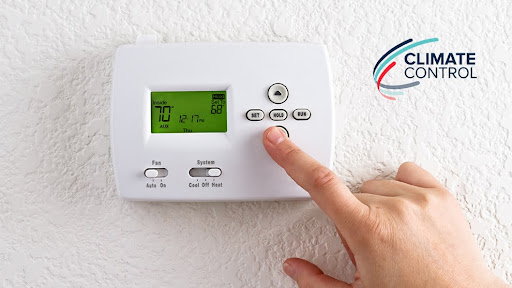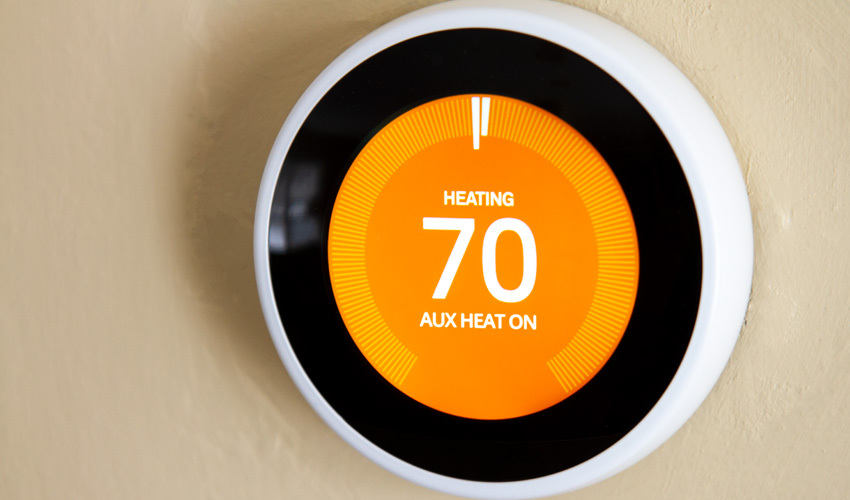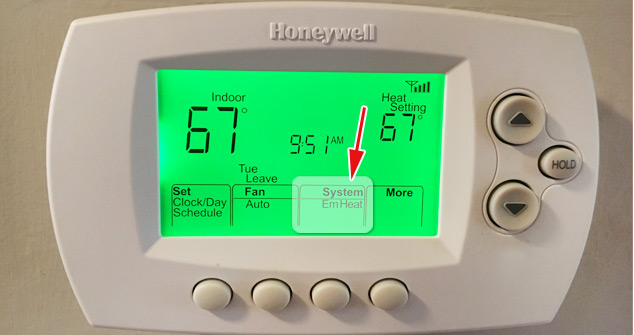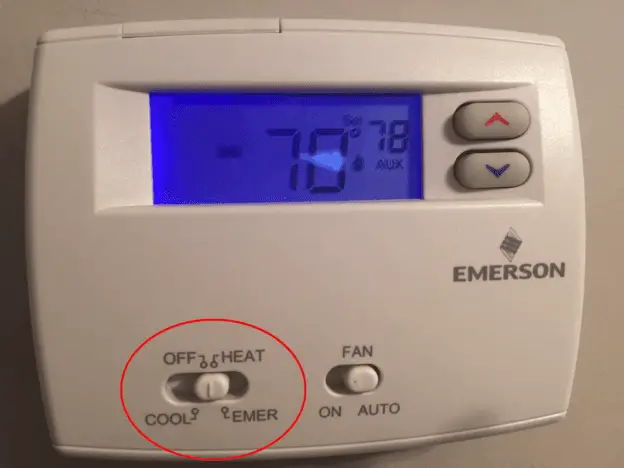Check Best Thermostat Pricing in Amazon
** As an Amazon Associate, I earn from qualifying purchases.
Aux Heat is a feature on many thermostats. It helps when the main heat source can’t keep up.
As winter chill sets in, your home needs reliable heat. Sometimes, your primary heating system struggles to maintain warmth. This is where aux heat steps in. Short for auxiliary heat, it provides a backup to ensure comfort. Whether your main system is overwhelmed or temporarily malfunctioning, aux heat kicks in to help.
Understanding this feature can help you manage your home’s heating more effectively. Let’s dive into what aux heat is, how it works, and why it’s essential for your thermostat. Stay warm and informed this winter!
Introduction To Aux Heat
Understanding the various settings on your thermostat can be a bit confusing, especially when you encounter terms like “Aux Heat.” If you’ve ever wondered what this setting means and why it’s important, you’re not alone. Let’s break it down in simple terms so you can make the most of your HVAC system.
Basic Concept
Aux Heat, short for Auxiliary Heat, is a secondary heating source used by your HVAC system. It kicks in when your primary heat pump can’t meet the heating demands of your home. This usually happens during extremely cold weather.
The primary heat pump works efficiently up to a certain temperature. Once it gets too cold, the Aux Heat takes over to ensure your home stays warm. Think of it as your heating system’s backup plan.
Importance In Hvac Systems
Why should you care about Aux Heat? Because it directly impacts your comfort and energy bills. If your heat pump is struggling, your home might not get warm enough, or your system might overwork itself.
A properly functioning Aux Heat ensures your home remains cozy even during those unexpected cold snaps. It also prevents your primary system from overworking, which can save you from costly repairs.
Imagine a particularly cold winter night. Without Aux Heat, your home might become uncomfortably chilly, making it hard to sleep. With Aux Heat, you can rest easy knowing your backup system is keeping you warm.
Have you ever checked your thermostat and noticed the Aux Heat indicator? Next time you see it, you’ll know your system is working hard to keep you comfortable, even in the coldest conditions.
How Aux Heat Works
Understanding how Aux Heat works can help you manage your home heating system better. Aux Heat, short for Auxiliary Heat, is a backup heating system. It activates when the primary heat pump cannot maintain the desired temperature.
Activation Process
The Aux Heat kicks in automatically. It activates when the outside temperature drops too low. The heat pump struggles to extract heat from the cold air. The thermostat then signals the Aux Heat to turn on. This ensures your home stays warm.
System Components
The Aux Heat system includes several key components. First, there is the heat pump. It works as the main source of heat. Next, there is the electric resistance heating element. This element provides the backup heat. The thermostat controls both the heat pump and the Aux Heat.
There are also sensors involved. These sensors monitor the outside temperature. They send data to the thermostat. The thermostat decides when to activate the Aux Heat. This coordination keeps your home comfortable even in freezing weather.
Aux Heat Vs. Emergency Heat
Understanding the difference between Aux Heat and Emergency Heat is important for homeowners with a heat pump system. Both functions help maintain warmth in your home, but they operate differently. Let’s dive into the key differences and when to use each option.
Key Differences
Auxiliary Heat (Aux Heat) kicks in when the heat pump alone cannot maintain the desired temperature. It acts as a supplement. It often uses electric resistance heating. Aux Heat activates automatically.
Emergency Heat is a manual setting. You turn it on when the heat pump fails. It relies entirely on the backup heating source. This is usually the electric resistance heater or a gas furnace. Emergency Heat bypasses the heat pump.
When To Use Each
Use Aux Heat during extremely cold weather. It supports the heat pump to keep your home warm. The thermostat switches to Aux Heat as needed.
Use Emergency Heat when the heat pump is not working. This ensures your home stays warm. Activate it manually through your thermostat.
Understanding these settings helps you manage your heating system. It ensures comfort and efficiency during cold months.

Credit: climatecontrolcompany.com
Common Scenarios For Aux Heat
Aux heat on a thermostat often activates during very cold weather. It helps maintain indoor warmth when the main heat pump struggles. This backup heat source ensures comfort in extreme conditions.
When your thermostat shows “Aux Heat,” it can be a bit confusing. This auxiliary heating system is designed to kick in under specific circumstances to keep your home warm. Let’s look at some common scenarios where you might see Aux Heat in action. ###Cold Weather Conditions
During extremely cold weather, your heat pump might struggle to maintain the set temperature. This is when Aux Heat steps in to help. I remember last winter, when temperatures dropped below freezing for several days. My heat pump couldn’t keep up, and Aux Heat became a lifesaver. It ensured my home stayed cozy, despite the bitter cold outside. Have you noticed your Aux Heat kicking in during a cold snap? ###Heat Pump Efficiency Issues
Sometimes, heat pumps become less efficient due to age or maintenance issues. When this happens, they can’t generate enough heat on their own. Aux Heat can temporarily compensate for this reduced efficiency. If your heat pump is older or hasn’t had regular maintenance, Aux Heat might activate more frequently. Regular maintenance can minimize the need for Aux Heat, saving you money. Have you scheduled your heat pump maintenance recently? Aux Heat is essential for maintaining comfort during specific conditions. Understanding when and why it activates can help you manage your thermostat more effectively.Energy Consumption
Understanding energy consumption is crucial when it comes to managing your thermostat’s aux heat. Aux heat, or auxiliary heat, is a backup heating system that kicks in when your primary heat pump can’t keep up with the desired temperature. This feature can significantly impact your energy usage and, consequently, your electricity bills.
Impact On Electricity Bills
Aux heat can cause your electricity bills to spike if not managed properly. This is because it relies on electric resistance heating, which is less efficient than your primary heat pump. Imagine your surprise when you open your electricity bill in the winter, only to find it much higher than expected!
Check Best Thermostat Pricing in Amazon
** As an Amazon Associate, I earn from qualifying purchases.
To avoid this, it’s essential to understand when and why aux heat is being activated. Is it due to extremely low outdoor temperatures, or are there other factors at play? Being aware of these triggers can help you manage your energy consumption more effectively.
Tips For Efficient Use
Here are some practical tips to ensure you use aux heat efficiently:
- Monitor your thermostat settings: Make sure your thermostat is set correctly for the season. A setting that’s too high may cause aux heat to kick in more frequently.
- Regular maintenance: Keeping your heating system in good condition can prevent unnecessary aux heat usage. Schedule regular check-ups to ensure everything is running smoothly.
- Insulate your home: Proper insulation can reduce the need for aux heat by maintaining your home’s temperature more effectively. Check for drafts and seal any gaps you find.
- Use a programmable thermostat: This can help you control when and how often aux heat is used. Program it to lower the temperature when you’re not home or during the night.
By following these tips, you can keep your energy consumption in check. What steps will you take to make your home more energy-efficient this winter? Share your thoughts and experiences in the comments below!
Troubleshooting Aux Heat Issues
Auxiliary heat, also known as aux heat, is a backup heating system. It activates when the primary heat pump can’t maintain the desired temperature. Sometimes, aux heat might not work as expected. Let’s explore how to troubleshoot aux heat issues effectively.
Common Problems
Several issues can cause aux heat to malfunction. These include a faulty thermostat, dirty air filters, and low refrigerant levels. Electrical problems may also affect the aux heat system. Identifying these common problems can help resolve the issue quickly.
Diy Solutions
Start by checking the thermostat settings. Make sure it is set to “heat” mode. Replace the batteries if needed. Next, inspect and clean or replace the air filters. Dirty filters can restrict airflow, causing aux heat problems. Also, check for any visible signs of electrical issues.
If the problem persists, consider calling a professional HVAC technician. They can check the refrigerant levels and inspect the heat pump for any underlying issues. Regular maintenance can prevent most aux heat problems and ensure your system runs efficiently.
Maintenance And Care
Maintaining your thermostat’s auxiliary heat function ensures optimal performance. Regular care and maintenance can prevent costly repairs. It also enhances your system’s longevity and efficiency. Below are some key steps to take.
Regular Checkups
Perform regular checkups on your thermostat. This helps catch issues early. Inspect for dust and debris. Clean the device to prevent malfunctions. Check the settings to ensure they are correct. Always replace batteries if needed. Regular checkups can save you from unexpected breakdowns.
Professional Services
Sometimes, you need professional help. Schedule yearly maintenance with an HVAC professional. They can inspect and service your system thoroughly. Professionals have the tools and knowledge to fix complex issues. They can also provide expert advice on optimizing your thermostat settings. Regular professional services can boost your system’s efficiency.

Credit: www.aireserv.com
Upgrading Your Thermostat
Upgrading your thermostat can improve your home’s comfort and efficiency. Many modern thermostats offer advanced features. These can help manage your heating system better. One important feature is Aux Heat. Understanding this can help you make an informed decision.
Smart Thermostats
Smart thermostats offer many benefits. They can learn your preferences and adjust settings automatically. This helps maintain a comfortable temperature while saving energy. Some models can be controlled through a smartphone app. This allows you to adjust the temperature from anywhere. Smart thermostats also provide detailed energy usage reports. This can help you identify ways to save on your energy bills.
Compatibility With Aux Heat
Not all thermostats are compatible with Aux Heat. It is essential to check if the smart thermostat supports Aux Heat. This ensures your heating system works efficiently. Aux Heat is crucial for heat pump systems. It provides extra warmth during very cold weather. Make sure the thermostat can manage this feature effectively.
Many smart thermostats have compatibility lists. Check these lists before purchasing. This will save you time and avoid potential issues. Some models may require professional installation. This ensures that all features, including Aux Heat, work correctly. Proper installation is vital for optimal performance. Consider consulting an HVAC professional for advice.

Credit: gopaschal.com
Frequently Asked Questions
Should Aux Heat Be On?
Aux heat should be on during extremely cold weather. It helps maintain your home’s temperature when the heat pump struggles. Use it sparingly to avoid high energy bills.
Why Does My Thermostat Keep Saying Aux Heat?
Your thermostat displays “aux heat” when the primary heating can’t keep up. It activates auxiliary heat for extra warmth.
Is Auxiliary Heat More Expensive?
Yes, auxiliary heat is generally more expensive. It uses more electricity, increasing energy bills. Use it sparingly for cost savings.
How Long Can I Run Auxiliary Heat?
You can run auxiliary heat for short periods during extreme cold. Limit usage to prevent high energy bills and wear.
Conclusion
Understanding aux heat on your thermostat can save energy and money. It kicks in during very cold weather, providing extra warmth. Regular maintenance ensures it works efficiently. Check your system if you notice high energy bills. Now, you’re better informed about aux heat.
Keep your home comfortable and your wallet happy. Stay warm and cozy all winter long.
Check Best Thermostat Pricing in Amazon
** As an Amazon Associate, I earn from qualifying purchases.


